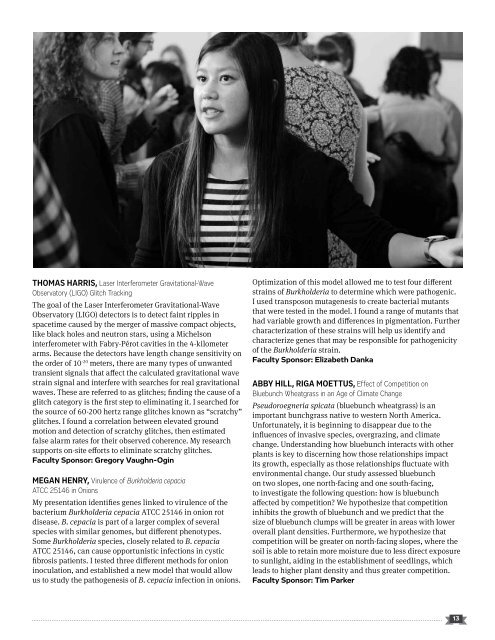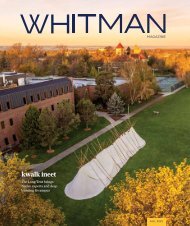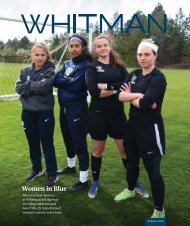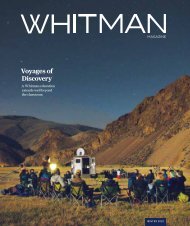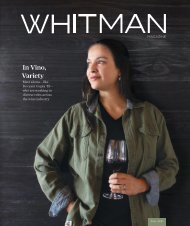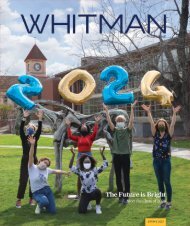You also want an ePaper? Increase the reach of your titles
YUMPU automatically turns print PDFs into web optimized ePapers that Google loves.
THOMAS HARRIS, Laser Interferometer Gravitational-Wave<br />
Observatory (LIGO) Glitch Tracking<br />
The goal of the Laser Interferometer Gravitational-Wave<br />
Observatory (LIGO) detectors is to detect faint ripples in<br />
spacetime caused by the merger of massive compact objects,<br />
like black holes and neutron stars, using a Michelson<br />
interferometer with Fabry-Pérot cavities in the 4-kilometer<br />
arms. Because the detectors have length change sensitivity on<br />
the order of 10 -20 meters, there are many types of unwanted<br />
transient signals that affect the calculated gravitational wave<br />
strain signal and interfere with searches for real gravitational<br />
waves. These are referred to as glitches; finding the cause of a<br />
glitch category is the first step to eliminating it. I searched for<br />
the source of 60-200 hertz range glitches known as “scratchy”<br />
glitches. I found a correlation between elevated ground<br />
motion and detection of scratchy glitches, then estimated<br />
false alarm rates for their observed coherence. My research<br />
supports on-site efforts to eliminate scratchy glitches.<br />
Faculty Sponsor: Gregory Vaughn-Ogin<br />
MEGAN HENRY, Virulence of Burkholderia cepacia<br />
ATCC 25146 in Onions<br />
My presentation identifies genes linked to virulence of the<br />
bacterium Burkholderia cepacia ATCC 25146 in onion rot<br />
disease. B. cepacia is part of a larger complex of several<br />
species with similar genomes, but different phenotypes.<br />
Some Burkholderia species, closely related to B. cepacia<br />
ATCC 25146, can cause opportunistic infections in cystic<br />
fibrosis patients. I tested three different methods for onion<br />
inoculation, and established a new model that would allow<br />
us to study the pathogenesis of B. cepacia infection in onions.<br />
Optimization of this model allowed me to test four different<br />
strains of Burkholderia to determine which were pathogenic.<br />
I used transposon mutagenesis to create bacterial mutants<br />
that were tested in the model. I found a range of mutants that<br />
had variable growth and differences in pigmentation. Further<br />
characterization of these strains will help us identify and<br />
characterize genes that may be responsible for pathogenicity<br />
of the Burkholderia strain.<br />
Faculty Sponsor: Elizabeth Danka<br />
ABBY HILL, RIGA MOETTUS, Effect of Competition on<br />
Bluebunch Wheatgrass in an Age of Climate Change<br />
Pseudoroegneria spicata (bluebunch wheatgrass) is an<br />
important bunchgrass native to western North America.<br />
Unfortunately, it is beginning to disappear due to the<br />
influences of invasive species, overgrazing, and climate<br />
change. Understanding how bluebunch interacts with other<br />
plants is key to discerning how those relationships impact<br />
its growth, especially as those relationships fluctuate with<br />
environmental change. Our study assessed bluebunch<br />
on two slopes, one north-facing and one south-facing,<br />
to investigate the following question: how is bluebunch<br />
affected by competition? We hypothesize that competition<br />
inhibits the growth of bluebunch and we predict that the<br />
size of bluebunch clumps will be greater in areas with lower<br />
overall plant densities. Furthermore, we hypothesize that<br />
competition will be greater on north-facing slopes, where the<br />
soil is able to retain more moisture due to less direct exposure<br />
to sunlight, aiding in the establishment of seedlings, which<br />
leads to higher plant density and thus greater competition.<br />
Faculty Sponsor: Tim Parker<br />
13


